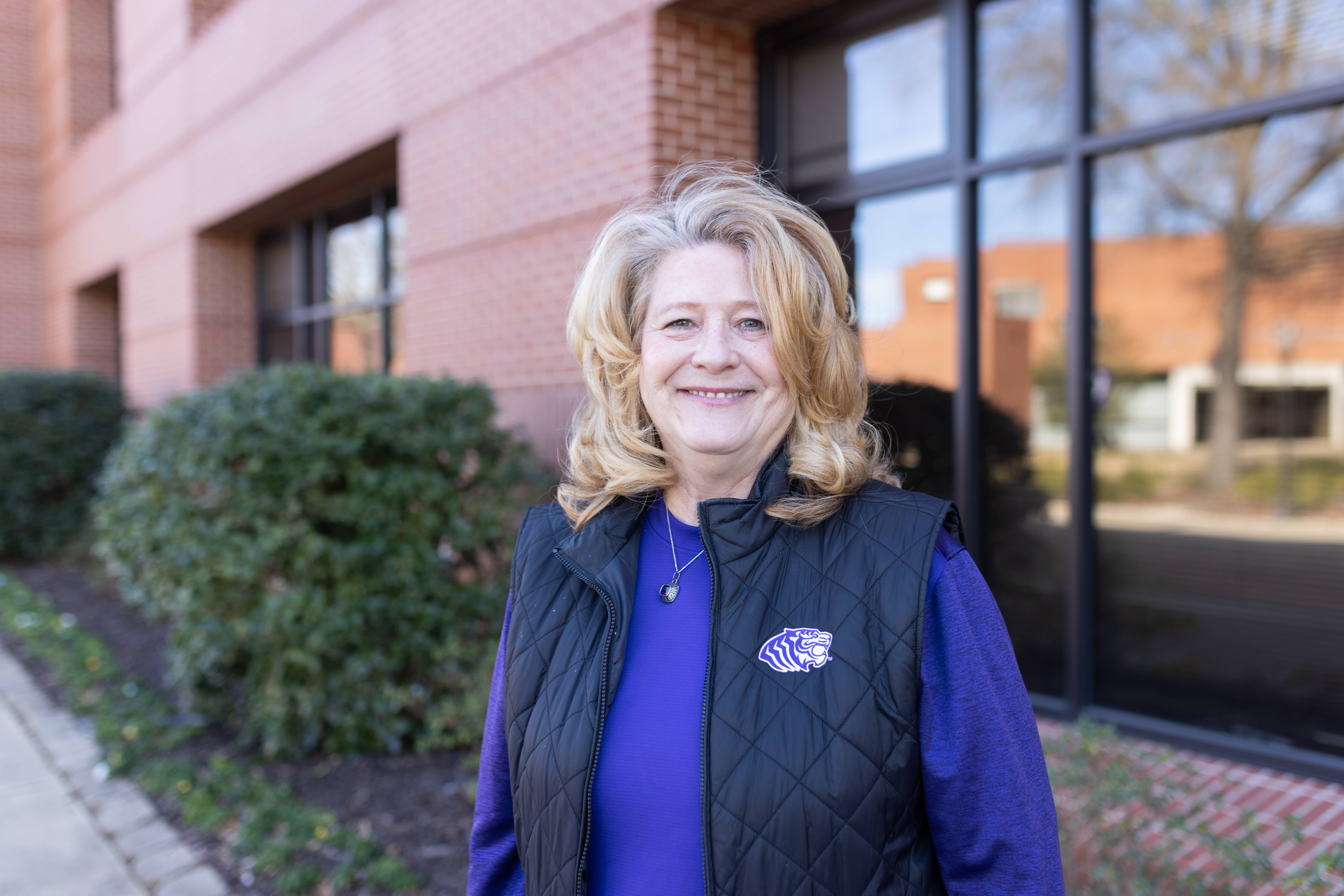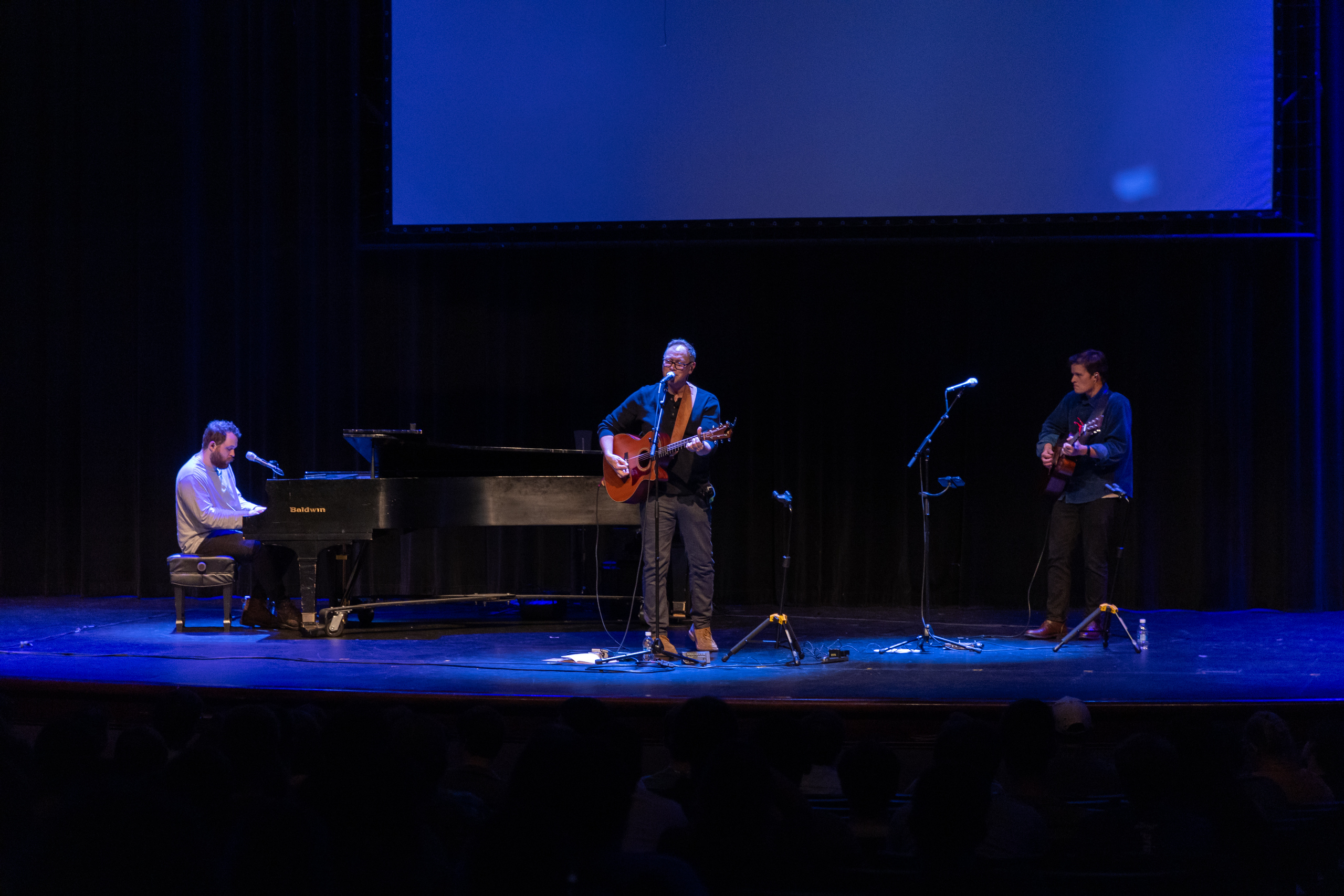
Desegregation: An Honors Seminar
Part 5 of 5
Fifteen honors students contemplated the desegregation of public schools through research on the movement’s early days and trips to key sites in the history of the Civil Rights Movement. The students visited the museum and toured the school at the Little Rock Central High School National Historic Site. Having just read Melba Beals’ Warriors Don’t Cry, the students saw the exterior of the building, where African-American students were initially denied entrance, as well as the cafeteria, hallways and auditorium where the Little Rock Nine persevered through the integration of Central High in 1957.
The honors students researched desegregation in their home towns or in nearby areas and produced portfolios detailing their findings. They also viewed the documentary Hoxie: The First Stand and read Black Like Me, by John Howard Griffin. The one-hour seminar concluded with a trip to the National Civil Rights Museum in Memphis.
In an earlier essay assignment, students were asked to reflect on their visit to Little Rock and on the book by Beals, one of African-American students who integrated Central High amid turmoil and national news coverage in 1957. Five of those reflection papers are listed here. The authors are: Sarah Greeson, a senior from Hot Springs; Jesse Pruett, a senior from Harrison; Kiley Gamble, a junior from McKinney, Texas; Michelle Wasmund, a freshman from Dennison, Texas; and Anna Wakeling, a freshman from Bryant.
Others students in the seminar were: T.J. Bailey, a sophomore from Ft. Smith; Kimberly Carlton, a senior from Brandon, Miss.; Kasa Cooper, a senior from Paragould; Ethan Day, a sophomore from Garland, Texas; Anthony Emerson, a sophomore from Fresno, Texas; Jacob Lively, a senior from Queen City, Texas; Nate Peace, a junior from Bedford, Texas; Jessica Reid, a sophomore from Grandview, Texas; Nolan West, a senior from Bolivar, Missouri; and Clark Whitney, a freshman from Searcy. The course was taught by Dr. Kevin Motl, assistant professor of history, and Dr. Jeff Root, professor of communications and dean of the school of humanities.
Reflection Paper
by Jesse Pruett
Having grown up in Harrison, Arkansas, I have been sheltered for most of my life from witnessing the events and subsequent conflicts surrounding the integration of races in schools. Due to the racial make-up of my school district, I never had to deal openly with the idea of having multiple races in the classroom. On account of this, as we studied the history of racial segregation and the troubling conflicts surrounding integration, it was, for the most part, a distant topic, a past that did not seem as large an issue as what it really was and is today. Of course, as most people today, I realized the evil and inequality of the system and necessity to reverse it but the importance of the issue had never really sunk in. However, as this semester has progressed, the issue has become much more real to me through the discussions in class, the video describing the events surrounding the Hoxie integration, Melba Beals’ book, and especially the visit to Central High School. As I reflect on these events, I realize that many of my former opinions concerning the past events of integration and current racial issues have changed rather interestingly.
One of the largest changes in my emotions surrounding the events of desegregation is the large amount of respect gained for those who endured the inequality of desegregation, those who worked tirelessly for integration, and for the young students who fought on the front lines of integration specifically the Little Rock Nine. Through the personal testimonies of the older generation in the Hoxie video and the early chapters of Warriors Don’t Cry, a window was opened into the personal experiences to those who actually endured the prejudices brought about by Jim Crow Laws across the South. In high school and on television, I had of course seen photographs of the day illustrating the separate facilities for both “whites” and the “colored” but had never listened to or read the actual emotions of those whose lives were affected by these rules. To read in Melba Beals’ account of her early days of accustoming herself to the customs of segregated Little Rock and the fear that she saw in the actions of the rest of her race were completely alien to me. To have to be extremely careful wherever you went that you did not unconsciously disturb a member of another race for fear of punishment at the hands of that race is something that I have never in my life experienced. One of the most horrifying events she described concerned the event surrounding her birth. As Melba was lying there on the brink of death, her mother frantically searched for any way to save her daughter only to find out, just in time, from a janitor who had overheard the doctor say that a simple cure of Epsom salts would cure the child. Even after discovering this, the nurse seemed apathetic seeing the race of the baby rather than the need for her to act and save a life. Through all of these experiences, it is no wonder that a young innocent child would see the obvious injustice and begin to question the older generation about these inequalities. As I began to move beyond this and heard stories about the individuals who helped change the system and the junk that they endured, my respect for these individuals skyrocketed. One such group of individuals is the Superintendant Kunkel Vance and the men of the Hoxie school board at the time of their school integration in 1955. At first, everything seemed to go according to plan as the first few days of the integrated school year passed by. However, as the southern media and anti-integration groups began their opposition to events in Hoxie, these individuals faced some incredibly fierce attacks against themselves and their families. Many of these men had their statuses in the community utterly destroyed as they were labeled “nigger lovers” or any one of numerous insults. Some even had their lives and the safety of their families threatened on a nightly basis over phone calls and personal visits from segregationist supporters. However, through all of the persecution and suffering, these men held the course and refused to reverse their decision. As a result, even after many had been voted out of office or had resigned and been replaced by segregationist leaders, the decision was never reversed and Hoxie remained an integrated school. Even though the stories of the individuals who fought for integration are inspiring, the most inspiring stories are those of the children who actually endured the perils of integration. Though had seen various movies and had read articles in history books, it was not until I read Warriors Don’t Cry that I even came close to understanding the absolute hell these young people had to endure. To have to attend school each day with the fear that this might be your last is incredibly shocking to me. Throughout her year at Central, Melba Beals had to endure a daily attack of verbal abuses, looks of hatred, and physical violence ranging from punching and kicking to even having a stick of dynamite thrown at her and acid being squirted in her eyes. However, through all of this suffering and even after one of their own, Minnijean Brown, had been unjustly expelled, Melba and the rest simply endured daily with incredible courage and, in the end, were victorious.
Another stark reality for me is the complete unnatural nature of desegregation. One of the most shocking and yet joyous footage of the events surrounding integration was the photographs taken by Life magazine during the first day of the Hoxie integration. In these photographs, children from both races were shown playing together and making friends as if nothing was truly different much to the shock and horror of segregation leaders. These innocent children who had not yet been raised to accept Jim Crow as a way of life saw nothing wrong with the racial mixture and simply enjoyed life together. However, the situation was much different after segregationists got involved in Hoxie and in the integration of Central High School where older students and adults who supported the system reacted violently to the undoing of Jim Crow. The point revealed in these contrasting incidents is that segregation is not a natural thing but an unnatural system without any logical backing forced upon individuals and simply endured as a way of life.
A further convicting realization for me is the actions committed by those who simply did nothing. As we read the stories and personal accounts of those who suffered through integration and see the pictures and clips that illustrate their trials, our accusations and blame are often directed at the Orville Faubuses and the Hazel Masserys who violently opposed integration using any means available to them. However, as I read Melba’s account of her hellish year at Central High School, one of the most striking horrors is that there were numerous students who did nothing at all when faced with the chaos of integration. They simply lived through the year as if nothing had changed. Of course, they were not directly harassing the Nine so, in their own minds, many probably felt their actions were justified. However, by removing themselves from the situation they gave silent approval to those who were causing the Nine to suffer. I am often left wondering what would have happened if some of the students had publically aided the Nine. Sure, there were some who occasionally smiled or gave words of encouragement giving the young black students much needed encouragement that probably helped them to survive the year. There were even some who dared to actually act, such as the young man Lint who warned Melba about future attacks. However, much of this aid was given in secret and very little effort was given to actually put an end to the violent attacks of the Nine especially from the Central High administration. When confronted with the evil around them, many saw their reputations and statuses amongst their peers as to great to come to the aid of someone of a different color. When confronted with this fact, it comes as an extreme conviction for me to examine my actions to see if I act justice for others or do I simply stand amongst the bystanders giving my silent approval as others suffer around me.
One final realization that has somewhat troubled me after my visit to Central High School is the lingering issue of racial segregation we still face today. Before, our visit to Central High School, I talked with another student on my floor who told me that the school to this day is still one of the most segregated schools he had ever witnessed. He described to me that he had met some of the most arrogant whites and poorest black students he had ever met from Central High School. While I admitted this might be true, I was unprepared for what truly lay ahead. As we stood in the halls after a drama production watching masses of students pass by, the divisions between whites and blacks were still apparent. The students naturally thronged to people of their own color and social group in the crowded halls. As we continued our tour, our guide described to us the different locations that students use during lunch: one race outside, the other inside. As we exited the building, the guide remarked on the social status of the different races by alluding to the fact that most of the white kids drive to school, the blacks ride the bus. Finally, after questioning our guide, she revealed that segregation exists even in the classroom based on the fact that while most AP and advanced classes are filled with whites and Asian-Americans, there are black students in the high school who can barely read and write beyond and elementary level. Even though fifty years ago one of the greatest battles and, subsequently one of the greatest victories for integration occurred in the halls of Central High, the school is still tragically segregated and unequal in a numerous of ways. This leads me to the conclusion that there is still much to be done to truly reverse the negative effects of Jim Crow upon American schools. I can only hope that with my experiences over the past few weeks that I can, even now in the majority white “Bubble” of OBU and in my future ministry, be a force for change in combating this issue.







